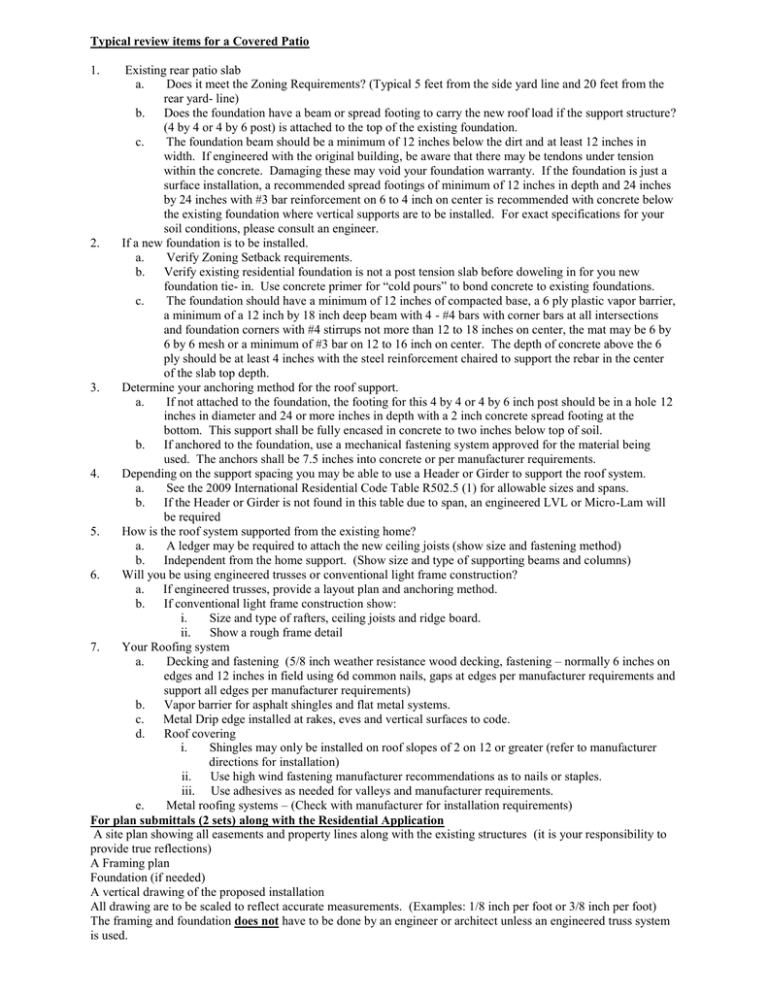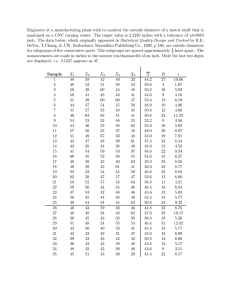Typical review items for a Covered Patio 1. Existing rear patio slab a
advertisement

Typical review items for a Covered Patio 1. Existing rear patio slab a. Does it meet the Zoning Requirements? (Typical 5 feet from the side yard line and 20 feet from the rear yard- line) b. Does the foundation have a beam or spread footing to carry the new roof load if the support structure? (4 by 4 or 4 by 6 post) is attached to the top of the existing foundation. c. The foundation beam should be a minimum of 12 inches below the dirt and at least 12 inches in width. If engineered with the original building, be aware that there may be tendons under tension within the concrete. Damaging these may void your foundation warranty. If the foundation is just a surface installation, a recommended spread footings of minimum of 12 inches in depth and 24 inches by 24 inches with #3 bar reinforcement on 6 to 4 inch on center is recommended with concrete below the existing foundation where vertical supports are to be installed. For exact specifications for your soil conditions, please consult an engineer. 2. If a new foundation is to be installed. a. Verify Zoning Setback requirements. b. Verify existing residential foundation is not a post tension slab before doweling in for you new foundation tie- in. Use concrete primer for “cold pours” to bond concrete to existing foundations. c. The foundation should have a minimum of 12 inches of compacted base, a 6 ply plastic vapor barrier, a minimum of a 12 inch by 18 inch deep beam with 4 - #4 bars with corner bars at all intersections and foundation corners with #4 stirrups not more than 12 to 18 inches on center, the mat may be 6 by 6 by 6 mesh or a minimum of #3 bar on 12 to 16 inch on center. The depth of concrete above the 6 ply should be at least 4 inches with the steel reinforcement chaired to support the rebar in the center of the slab top depth. 3. Determine your anchoring method for the roof support. a. If not attached to the foundation, the footing for this 4 by 4 or 4 by 6 inch post should be in a hole 12 inches in diameter and 24 or more inches in depth with a 2 inch concrete spread footing at the bottom. This support shall be fully encased in concrete to two inches below top of soil. b. If anchored to the foundation, use a mechanical fastening system approved for the material being used. The anchors shall be 7.5 inches into concrete or per manufacturer requirements. 4. Depending on the support spacing you may be able to use a Header or Girder to support the roof system. a. See the 2009 International Residential Code Table R502.5 (1) for allowable sizes and spans. b. If the Header or Girder is not found in this table due to span, an engineered LVL or Micro-Lam will be required 5. How is the roof system supported from the existing home? a. A ledger may be required to attach the new ceiling joists (show size and fastening method) b. Independent from the home support. (Show size and type of supporting beams and columns) 6. Will you be using engineered trusses or conventional light frame construction? a. If engineered trusses, provide a layout plan and anchoring method. b. If conventional light frame construction show: i. Size and type of rafters, ceiling joists and ridge board. ii. Show a rough frame detail 7. Your Roofing system a. Decking and fastening (5/8 inch weather resistance wood decking, fastening – normally 6 inches on edges and 12 inches in field using 6d common nails, gaps at edges per manufacturer requirements and support all edges per manufacturer requirements) b. Vapor barrier for asphalt shingles and flat metal systems. c. Metal Drip edge installed at rakes, eves and vertical surfaces to code. d. Roof covering i. Shingles may only be installed on roof slopes of 2 on 12 or greater (refer to manufacturer directions for installation) ii. Use high wind fastening manufacturer recommendations as to nails or staples. iii. Use adhesives as needed for valleys and manufacturer requirements. e. Metal roofing systems – (Check with manufacturer for installation requirements) For plan submittals (2 sets) along with the Residential Application A site plan showing all easements and property lines along with the existing structures (it is your responsibility to provide true reflections) A Framing plan Foundation (if needed) A vertical drawing of the proposed installation All drawing are to be scaled to reflect accurate measurements. (Examples: 1/8 inch per foot or 3/8 inch per foot) The framing and foundation does not have to be done by an engineer or architect unless an engineered truss system is used.



